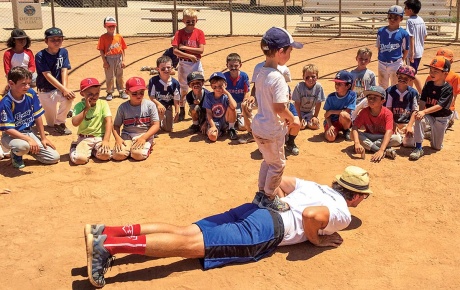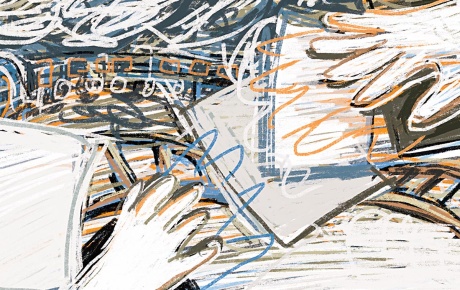Fight Like an Egyptian
A course taught once each Brown generation re-enacts the ancient Battle of Kadesh.

On a cloudless, sunny April afternoon, hundreds gathered on the Quiet Green. A voice blared through a megaphone: “Hey, anyone want to join the battle? Come fight with us!” And a loud spectacle began on the so-called Quiet Green, which on that day was bisected by a snaking sheet of blue vinyl intended to represent the Orontes River in modern-day Syria.
Roughly 90 students dressed as ancient Egyptian and Hittite soldiers, situated in chariots and armed with homemade shields, bows, swords, and spears, proceeded to re-enact the Battle of Kadesh, in which the pharaoh Ramesses II led an Egyptian army in a massive chariot battle against the Hittite Empire in 1274 B.C.E.
“The Battle of Kadesh has gotten interest from a really broad swath of society for a long time,” says Laurel Bestock, an associate professor of archaeology and Egyptology and
Assyriology who teaches Fighting Pharaohs: Ancient Egyptian Warfare. “It’s particularly fascinating because it looks really well documented. And then as soon as we try and get closer to it, we realize how much we’re missing—how much we don’t know about the perspectives of anyone other than the king in this battle.”

In the battle reconstruction, Bestock encourages students to take creative liberties to fill in those knowledge gaps. But the performance’s witty dialogue and its modern-day pop-culture references were underscored by months of rigorous academic research into how wars were fought from 3000 to 1000 B.C.E. Students formed separate committees dedicated to finance and logistics, scriptwriting, choreography,
costumes, props, and outreach.
“We’re actually doing real research and classwork, but having the battle as a vehicle for learning about Egyptian warfare has been really cool,” explains Christopher Bianco ’25, who played the commander of Ramesses’s Amun division. “It’s all so hands-on and a very engaging way to learn.”
“The students do different things with it each time,” Bestock says. “This is one of the joys of teaching…seeing what new students and their new generations bring to this material opens up new questions. It’s really fun for me as a human being, but it also sparks my interest as a scholar and feeds me as I continue to develop new research projects myself.”
The course doesn’t focus solely on the battle, but its reconstruction has reached legendary status on campus. Part of that is due to its frequency. “It’s never been repeated more than once per generation of undergraduates,” Bestock says. “So if you’re at Brown and you see this class, you should take it when it’s offered.”
Marine Corps veteran Jared Yee ’27, who’s pursuing concentrations in international and public affairs and economics, says one of his fellow student-veterans who studies archaeology convinced him and two other student-veterans to sign up. “I originally had no interest in ancient Egypt,” Yee says, “and suddenly it’s become one of my favorite periods of history to study. I have learned an enormous amount.”—MAGGIE SPEAR
Translate the 4,000-year-old Stela of Heni. Most patrons of the RISD Museum’s ancient Egypt exhibit are exempt from this task, but Professor Christelle Alvarez’s Middle Egyptian I students are not most patrons. Alvarez’s students have spent the entire fall semester learning to decipher hieroglyphs. Now, on a gray November afternoon, they’re gathered on the museum’s sixth floor, worksheets in hand. “This is the vase, right?” one sophomore asked his friend, inspecting the Stela. “Should we say the f below the deceased is the determinative for man?” said another. “I think that’s from the First Intermediate Period,” teaching assistant Livia Hoffman ’25 said to another TA. She walked to check the info plaque and smiled—“Nailed it.”
Before arriving at Brown last fall, Professor Alvarez had never instructed a group of students who weren’t planning on becoming Egyptologists themselves. “How do I adapt my material to make sure that the students who want to continue have a good basis, but the students that just want to do one semester and have a grasp of a few concepts also follow?” she asked herself. She decided to help students decode the types of artifacts that are typically found in museums, and the RISD visit was the culmination of months of hard work.
Luckily, a comprehensive knowledge of Middle Egyptian isn’t necessary to get the gist of most artifacts. “I think the beauty of hieroglyphs is that there’s a lot of repetition, especially on the artifacts you can find in museums,” says Hoffman. Professor Alvarez agrees. “Ancient Egyptians liked to really fill up the space, but sometimes if you’ve managed to just spot a few elements, then you get a sense of what it is,” she explains.
Yet identifying only the most necessary elements can still be quite a challenge. “When you’re reading Spanish…the word written on paper represents a linguistic construct in your head,” says TA Eric Gottlieb ’25. “But when you see hieroglyphs, you have to do a whole other extra level where you turn the images into words before turning those words into meanings.” Even trickier, Middle Egyptian words are not spelled consistently. Sometimes a particular concept will be spelled using multiple glyphs, with each sign representing one sound in the word. Other times, the same concept will be represented by a single glyph communicating all of the sounds.
“It is just really like a puzzle,” Hoffman says. “When it clicks, it’s a great feeling.”
Unlike other Egyptian scripts that don’t feature hieroglyphs, Middle Egyptian was used on monuments for almost as long as ancient Egypt existed. “If you know hieroglyphs, you are not only reading texts from one particular period, you can read hieroglyphs from 3,000 years,” says Professor Alvarez. Additionally, Middle Egyptian was popular during the “classical period” of ancient Egyptian history, so hieroglyphs are the key to a rich world of literature for those who do want to concentrate in Egyptology.
“The stories you read are unlike anything I’ve ever read in my life,” says Gottlieb. One text, The Shipwrecked Sailor, charts the journey of a sailor who becomes stranded on an island with a giant talking snake. The man soon comes to understand the snake, a reasonable companion who is mourning the tragic loss of his reptilian family. When the sailor returns home and recounts his journey, his boss is not impressed. “The sailor tells his lord, ahh, I met this amazing god, and the lord is like, I don’t care. I have lost an entire crew and now the governor is going to kill me,” Eric recounts, laughing. “It really makes these people very human in ways that you never ever would experience them otherwise.”—MEG TALIKOFF ’25





